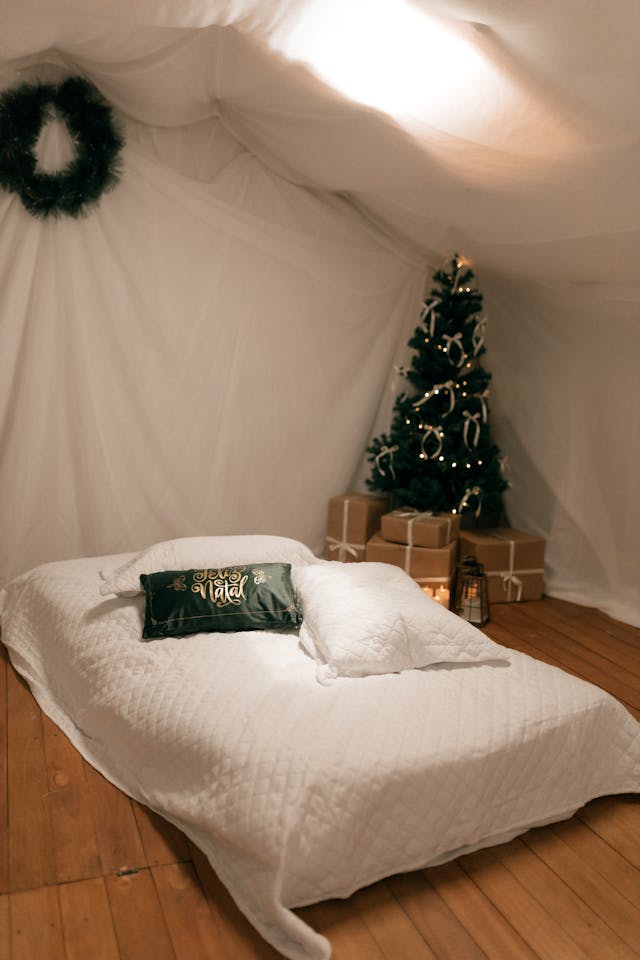Memory Foam vs Latex for Murphy Bed: What’s the Best Option?
Choosing the right mattress for your Murphy bed matters more than you think. In this guide, we compare memory foam vs latex for Murphy bed setups so you can maximize comfort, protect your mechanism, and keep storage simple—without wasting space.
Key Takeaways: memory foam vs latex for Murphy bed
- Memory foam flexes easily, stores vertically without shifting, and delivers top-tier pressure relief and motion isolation—an excellent everyday match for Murphy beds.
- Latex feels buoyant, breathable, and durable, but it’s heavier and less compliant—trade-offs that can complicate vertical storage and cabinet clearance.
- Keep mattress height to 10–12 inches for most mechanisms to close cleanly and safely.
Looking for more space-saving bed ideas? Explore our space-saving bed frame solutions.
What Is a Murphy Bed?
A Murphy bed—also called a wall bed—folds vertically into a wall or cabinet to free up floor space. The mattress rests upright when stowed, so materials need to tolerate vertical storage and occasional compression. For a quick primer, see Sleep Foundation’s overview of Murphy beds and Better Homes & Gardens’ Murphy bed explainer.

Top Benefits of Memory Foam for Murphy Beds
1) Answer first: Memory foam is the most flexible, fold-friendly option.
Memory foam compresses smoothly when you lift the frame and regains its shape when lowered. That flexibility helps minimize stress on the hinge and cabinet while keeping the mattress looking tidy during vertical storage.
Compared with latex, memory foam tends to bend more predictably at the strap locations and resists shifting while upright—both handy traits for a memory foam vs latex for Murphy bed decision.

2) Answer first: It absorbs motion and eases pressure points.
Because memory foam conforms deeply, it dampens movement from a restless partner and cushions joints for side and back sleepers. If guest comfort is the priority, memory foam usually wins the memory foam vs latex for Murphy bed matchup for motion isolation and pressure relief. For general pressure-relief and material differences, see Sleep Foundation’s comparison of memory foam and latex.
3) Answer first: All-foam builds are lighter—good for lift systems.
Pure foam mattresses usually weigh less than latex of the same thickness. Less weight helps the gas pistons or springs in a Murphy bed operate smoothly and can extend hardware life. If your cabinet has tight tolerances, pairing a lighter mattress with a 10–12″ profile is a practical choice in the memory foam vs latex for Murphy bed debate.
Benefits & Considerations of Latex Mattresses
Answer first: Latex is breathable and bouncy, but heavier and stiffer.
Latex delivers a responsive, “on-the-mattress” feel, excellent airflow, and strong durability. Natural latex can appeal to shoppers seeking organic bedding and sustainable bedding choices. Yet latex is denser and less compliant than most memory foams—qualities that can make vertical storage trickier and increase strain on your lift system.
If you’re set on latex for its eco profile, consider thinner builds and gentler storage habits. For a neutral overview of latex feel and performance, check Sleep Foundation’s memory foam vs latex guide.

How to Choose the Right Mattress Variant
Answer first: Match thickness and weight to your hardware, then pick feel.
- Check your specs: Many setups work best with 10–12″ heights. More than that can stress the latch or keep the cabinet from closing. For general thickness guidance, see Sleep Foundation on mattress thickness.
- Prioritize weight & flexibility: All-foam models typically bend and stow more cleanly than latex or coil-heavy hybrids in a memory foam vs latex for Murphy bed context.
- Cooling considerations: If you sleep hot, prioritize breathable covers, open-cell foams, or naturally airy latex. Parachute’s primer on materials and breathability is a helpful read: buying the right mattress.
- Allergy & eco preferences: Natural latex is a strong pick for shoppers focusing on eco-conscious sheets, organic materials, and low-VOC construction—just mind the extra mass and rigidity.
Best Options Compared
Here’s how the two materials stack up when you’re deciding on memory foam vs latex for Murphy bed storage and everyday comfort.
| Option | Pros | Cons | Best For |
|---|---|---|---|
| Memory Foam (standard or gel) | Lightweight, folds easily, top motion isolation & pressure relief | Can sleep warm without cooling tech; softer edges | Guest rooms, couples, pain relief, easy storage |
| Latex | Breathable, springy feel, highly durable, natural materials | Heavier and stiffer for vertical storage; may stress hardware | Eco-focused users, hot sleepers who prefer buoyancy |
Practical Setup Tips for Your Murphy Bed
Answer first: Keep it secure, breathable, and within spec.
- Use the right straps: Secure the mattress at the recommended points so foam doesn’t drift when upright. This reduces body-imprint risk over time.
- Mind the profile: Shoot for 10–12″ total height including any topper. If you add a topper later, re-check cabinet clearance.
- Ventilate the cabinet: Airflow matters for both memory foam and latex. Crack doors or choose vented panels if possible.
- Rotate periodically: Quarterly rotation can help even out wear—useful for both sides in the memory foam vs latex for Murphy bed decision.
- Foundation matters: Follow your bed maker’s slat spacing or panel guidance for safe support. For general bed-type context, see BHG’s overview of bed types.
Eco-Friendly Angle: Can Latex Be the Greener Pick?
Answer first: Natural latex leans greener; memory foam can still be thoughtful.
Natural latex often includes organic certifications and excels at airflow and longevity—appealing for organic bedding and sustainable bedding shoppers. However, its weight and rigidity can be awkward for repeated vertical storage. Memory foam, meanwhile, is widely available with low-VOC foams and recycled content in covers; some brands offer open-cell designs to improve breathability.
Prefer the latex feel? Opt for a leaner 10″ build to trim weight, and store the bed down when practical. Prefer the memory-foam hug? Choose breathable covers and ventilated cores. Either way, pair the mattress with eco-conscious sheets to round out a lower-impact sleep setup.
Buyer’s Guide: Dial in Your Best Choice
Answer first: Start with use-case, then pick material and firmness.
Frequent use & daily storage: Memory foam is generally easiest to live with in a Murphy bed. It bends cleanly, weighs less, and resists motion transfer. In many homes, it’s the “set-and-forget” winner for memory foam vs latex for Murphy bed practicality.
Occasional use, eco priority: Latex can work if the bed isn’t stored nightly and the lift hardware is robust. Choose a thinner profile and confirm your mechanism’s weight capacity.
Hot sleepers: Latex is naturally airy. For memory foam, pick open-cell or breathable covers and consider a light, cotton-rich sheet set for airflow (see Parachute’s material notes in their mattress guide).
Thickness & firmness: Many sleepers find 10–12″ hits the sweet spot for comfort and cabinet clearance. Side sleepers often like medium to medium-soft; back/stomach may prefer medium-firm. For general thickness considerations, see Sleep Foundation.
Quick Answer
Choose a memory foam mattress 10–12″ thick for the most reliable blend of flexibility, comfort, and storage compatibility in a Murphy bed. It hugs curves, isolates motion, and bends without fighting your hardware—traits that often decide memory foam vs latex for Murphy bed choices in favor of foam. If you love latex for its natural, springy feel and store the bed less frequently, it can work—just plan for extra weight and a slightly stiffer fold.
FAQ
- Can I use a hybrid or innerspring mattress in a Murphy bed?
- Some hybrids can work but tend to be heavier and less compliant than all-foam. Traditional innersprings are usually too rigid for frequent vertical storage.
- Is 12 inches too thick?
- It depends on your cabinet and locking hardware. Many systems handle 10–12″ best—always verify specs before buying.
- How do I keep a memory foam mattress cool?
- Look for breathable covers and open-cell or ventilated foams, and pair with lightweight sheets. Parachute’s buying guide covers breathability basics: mattress materials & heat.
- Will memory foam off-gas?
- A mild “new mattress” smell is common and usually fades within a few days. Ventilate the room, and unbox early before first use.
Keep Exploring (Cozy Bed Quarters)
- Finding the Perfect Mattress for Murphy Beds
- Space-Saving Bed Frames: 5 Smart Solutions
- Discover Space-Saving Bed Frame Solutions
- Understanding Latex Mattresses
- Memory Foam vs Spring: Honest Comparison
- Organic & Eco-Friendly Mattresses
Trusted External Resources
- Sleep Foundation: What Is a Murphy Bed?
- Sleep Foundation: Memory Foam vs Latex
- Parachute Home: Buying the Right Mattress
Final Thoughts
For most households, memory foam vs latex for Murphy bed decisions come down to storage behavior. Memory foam is easier on your lift system and offers plush, pressure-relieving comfort—especially when the bed goes up and down a lot. Latex shines for breathability and bounce, but its weight and rigidity mean you should store it upright less often. Whichever material you choose, confirm thickness, mind weight, and prioritize airflow. For more space-smart ideas and bedding guidance, explore the resources at Cozy Bed Quarters.
Related Reading
From Cozy Bed Quarters
- Finding the Perfect Mattress for Murphy Beds
- Space-Saving Bed Frame Solutions
- Organic & Eco-Friendly Mattresses
From Trusted Sources
- Sleep Foundation: Best Murphy Beds
- Better Homes & Gardens: What Is a Murphy Bed?
- Sleep Foundation: How Thick Should a Mattress Be?























